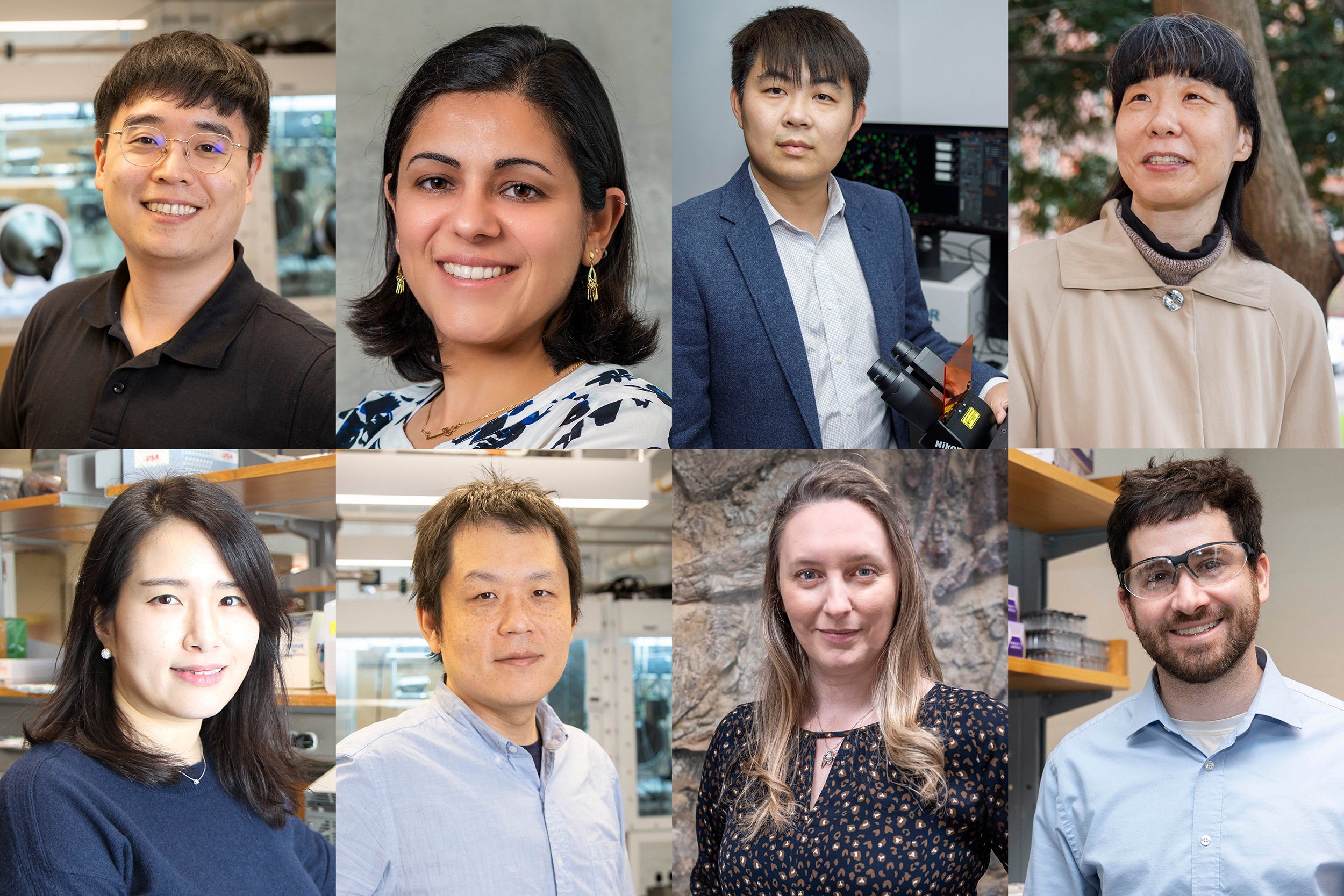
Joonho Lee (clockwise from top left), Rita Hamad, Fei Chen, Miaki Ishii, Jarad Mason, Stephanie Pierce, Suyang Xu, and Jeeyun Chung.
Photo credits (clockwise from top left): Niles Singer/Harvard Staff Photographer; Rhett Jones Jr. Photography; Stephanie Mitchell/Harvard Staff Photographer; Kris Snibbe/Harvard Staff Photographer; photo by Dylan Goodman; Jon Chase/Harvard Staff Photographer; Niles Singer/Harvard Staff Photographer; Harvard Molecular and Cellular Biology
Complex questions, innovative approaches
Seven projects awarded Star-Friedman Challenge grants
Seven creative, cutting-edge projects in disciplines ranging from chemistry to health equity are winners of the 2024 Star-Friedman Challenge for Promising Scientific Research.
In its 11th year, the Star-Friedman Challenge provides seed funding for novel research in the physical or social sciences, with an emphasis on new directions that might not otherwise be supported through traditional funding channels.
The program was first established in 2013 by a gift from James A. Star ’83 and expanded five years later by support from Josh Friedman ’76, M.B.A. ’80, J.D. ’82, and Beth Friedman. This year’s awardees were celebrated April 18.
Neuromodulatory effects of stabilized endogenous peptides
Fei Chen, Assistant Professor, Department of Stem Cell and Regenerative Biology; Core Faculty Member, Broad Institute
Small strings of amino acids called peptides, including insulin, oxytocin, and leptin, serve important functions in the body and hold promise as biologic drugs. The use of peptides for therapeutic purposes has been hampered by their quick degradation, and many nervous-system-soluble peptides have not been well characterized due to their instability. Chen and colleagues will develop libraries of stabilized peptides to characterize their cell-type activity in the nervous system. Their aim is to identify stabilization strategies for more than 100 bioactive peptides.
Why do we have fat-handling organelles in neurons?
Jeeyun Chung, Assistant Professor, Department of Molecular and Cellular Biology
Lipid droplets are organelles inside cells that store fatty acids and regulate many cellular functions, but their roles in brain cells, such as neurons, remain unclear. Chung will elucidate the molecular characteristics, regulation, and functions of neuronal lipid droplets to understand how their metabolism contributes to nervous system health and function. The research should provide new insights into the role of lipid droplets in neurological disorders.
Advancing health equity by increasing take-up of U.S. poverty alleviation programs
Rita Hamad, Associate Professor, Department of Social and Behavioral Sciences, Harvard T.H. Chan School of Public Health
The Earned Income Tax Credit is the largest U.S. poverty alleviation policy for families with children. It provides up to $7,400 annually for working families as a tax refund, and it has well-established health benefits. Yet one in four eligible families do not claim the benefit, in part because of the complexity of tax filing. Hamad will lead a study to identify actionable and scalable approaches for increasing take-up of the tax credit to advance health equity.
Unlocking the treasure trove: Analog data for studying climate change and beyond
Miaki Ishii, Professor, Department of Earth and Planetary Sciences
Increasing temperatures are bringing severe weather phenomena, from floods to fires, which cause billions of dollars in damages each year. Ishii and colleagues will use more than 150 years of historical weather observations to document how such extreme weather events have been worsening since the pre-industrial era. She will lead the creation of software to efficiently convert analog meteorological data to digital, and to demonstrate the significant value of historical data for climate research and more. The team will work with Seikei University in Tokyo to salvage massive amounts of historical weather data that exists only in paper or analog form.
Transforming organ storage with porous water
Jarad Mason, Associate Professor, Department of Chemistry and Chemical Biology
Korkut Uygun, Associate Professor, Department of Surgery, Harvard Medical School; Director of Cell, Tissue, and Organ Resource Core at Massachusetts General Hospital; Deputy Director of Research, Shriners Hospital for Children
Organ transplantation is a life-saving treatment for patients with end-stage organ failure. Every year, thousands of potentially transplantable organs are lost or rejected because they incur damage due to lack of oxygen while they’re stored and transported to the patient. The researchers will explore innovations from Mason’s lab in microporous water, loaded with nanoparticles that carry high densities of oxygen, that could enable longer preservation times for organs and save more lives.
Biodiversity collapse and recovery at the end of the world: Using East Gondwana’s fossil record to understand Earth’s greatest mass extinction
Stephanie Pierce, Professor, Department of Organismic and Evolutionary Biology; Alexander Agassiz Professor of Zoology, Museum of Comparative Zoology
Studying mass extinction events in the deep past can provide a unique perspective for understanding current and future impacts of climate change. Pierce proposes to focus on the largest biodiversity crisis in the history of life, the Permo-Triassic Mass Extinction, which occurred 252 million years ago and ended in 90 percent of all species vanishing. Her team will conduct paleontological excavations along the Bowen Basin in Australia, which is part of the eastern Gondwanan supercontinent, now modern Australia and New Zealand. Her aim is to chronicle biodiversity collapse and recovery in this relatively poorly studied but historically significant region, and the extent to which geography may influence survival outcomes.
Bridging quantum chemistry and physics by chirality
Suyang Xu, Assistant Professor, Department of Chemistry and Chemical Biology
Joonho Lee, Assistant Professor, Department of Chemistry and Chemical Biology
In chemistry, a molecule is said to be chiral if it cannot be superimposed on its mirror image — much like the left hand placed on top of the right. Chirality determines many molecules’ chemical, pharmaceutical, and biochemical properties, but there is currently no general strategy for driving chemical reactions that control for chirality. The researchers are proposing a new way to synthesize chiral molecules based on electronic selectivity, rather than structural selectivity, as is typically used in chemical engineering. They will leverage breakthroughs in quantum materials to define a precise, efficient process for developing molecules with specific chiral properties.





